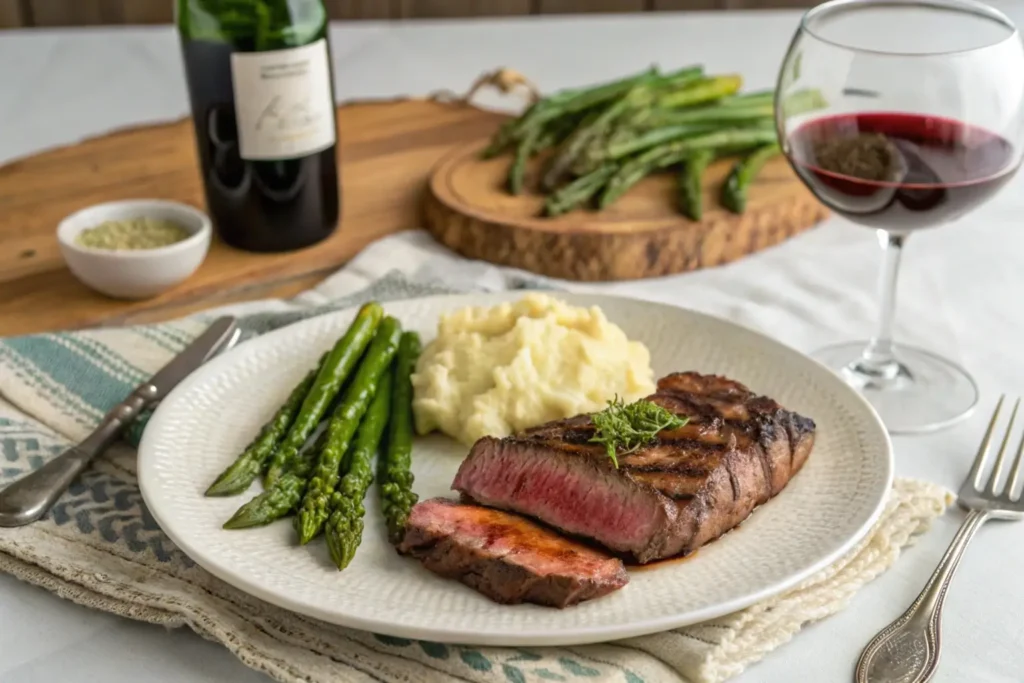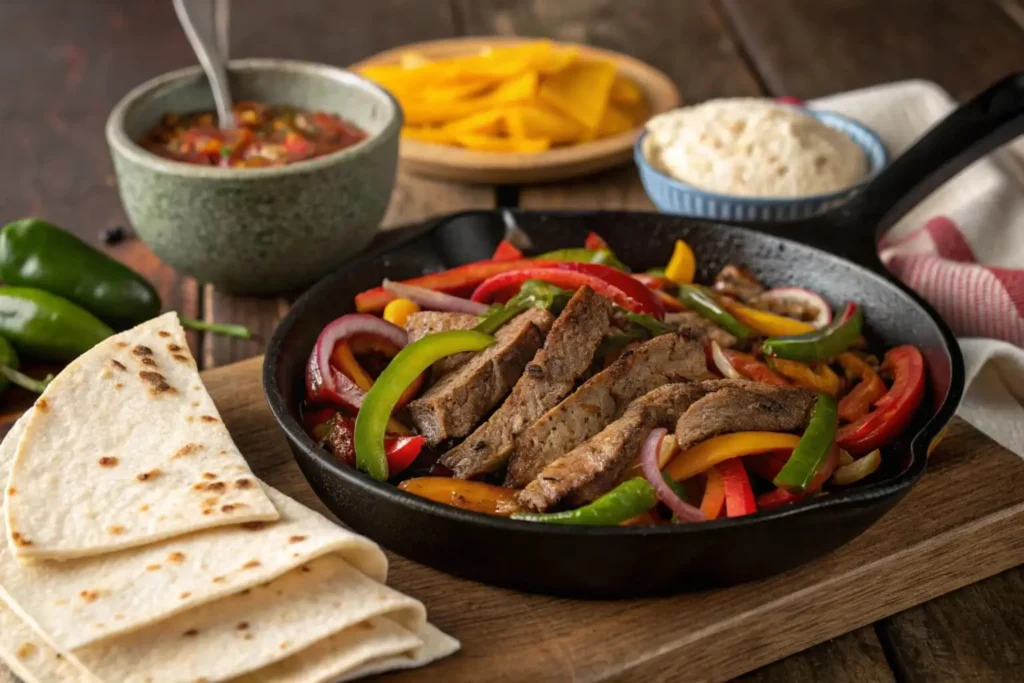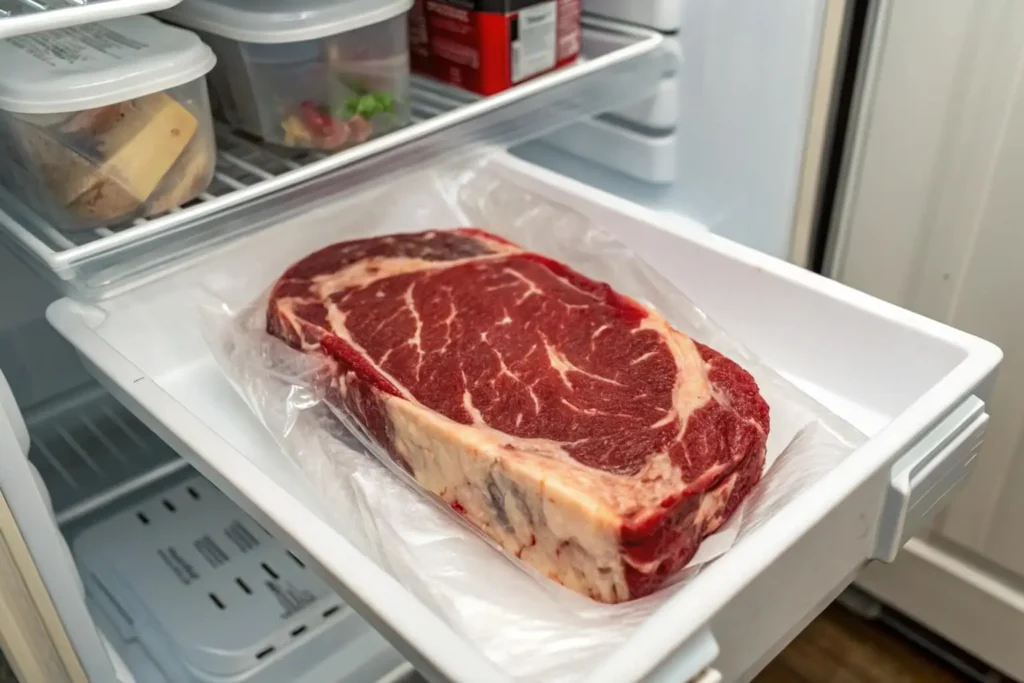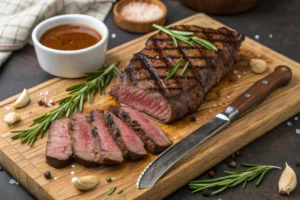Table of Contents
What is Ranch Steak?
Ranch steak, also known as “shoulder center steak” or “arm steak,” is a lean and versatile cut of beef that comes from the shoulder or chuck primal area of the cow. This steak is prized for its affordability, rich flavor, and adaptability to various cooking methods. shoulder steak has a fine-grain texture, making it an excellent choice for marination, which enhances both its tenderness and taste.
Origin and History of Ranch Steak
The history of shoulder steak traces back to American cattle ranching traditions, where resourceful ranchers utilized every part of the cow. shoulder steak became popular due to its robust flavor and cost-effectiveness, making it a staple in homes and steakhouses alike. Its reputation grew as chefs and home cooks developed creative ways to maximize its potential through tenderizing and cooking techniques.
How shoulder steak Differs From Other Cuts
While ranch steak is sometimes overlooked compared to premium cuts like ribeye or filet mignon, it offers unique qualities that stand out:
- Lean Composition: shoulder steak has less marbling than premium cuts, making it a healthier option without sacrificing flavor.
- Affordability: Its lower price point makes it a popular choice for budget-conscious meat lovers.
- Cooking Versatility: Unlike some cuts that require specific preparation methods, shoulder steak adapts well to grilling, pan-searing, and more.
Nutritional Profile of Ranch Steak
shoulder steak is not just flavorful; it’s also a nutrient-dense option. Here’s a look at its key nutritional highlights:
Calorie Count
shoulder steak is a moderate-calorie option. A 3-ounce serving contains approximately 150-180 calories, making it a smart choice for those managing calorie intake while enjoying a hearty meal.
Protein Content and Benefits
A typical serving provides 22-25 grams of protein, supporting muscle growth, repair, and overall body function. This high protein content makes it particularly beneficial for athletes and fitness enthusiasts.
Vitamins and Minerals in shoulder steak
shoulder steak is rich in essential nutrients, including:
- Iron: Promotes healthy red blood cells and combats fatigue.
- Zinc: Supports immune function and skin health.
- B Vitamins: Boosts energy levels and aids in metabolism, particularly B6 and B12.
Choosing the Perfect Ranch Steak
Selecting the right cut of shoulder steak is the first step toward a delicious and satisfying meal. Here’s how to ensure you’re getting the best quality.
Tips for Selecting Quality Cuts
When choosing shoulder steak, look for:
- Color: The meat should have a bright, cherry-red color. Avoid dull or brownish hues, as they indicate age or poor handling.
- Texture: shoulder steak should feel firm to the touch, with a smooth surface and minimal visible connective tissue.
- Marbling: Although lean, a good shoulder steak may have slight marbling, which enhances flavor.
How to Identify Fresh shoulder steak
Fresh shoulder steak will have a clean, neutral smell. Any off-putting or sour odor could be a sign that the meat is past its prime. Additionally, inspect the packaging for tight seals and no excess liquid, as this indicates freshness.
Grass-Fed vs. Grain-Fed Options
- Grass-Fed Ranch Steak: Tends to have a more robust flavor and leaner texture. It’s also higher in omega-3 fatty acids.
- Grain-Fed Ranch Steak: Offers a milder, buttery taste due to slightly higher fat content, making it more tender.
Preparing Ranch Steak
Once you’ve selected your steak, proper preparation can make all the difference in taste and texture.
Essential Tools for Cooking
Having the right tools will elevate your ranch steak experience. Consider using:
- A sharp chef’s knife for trimming excess fat.
- A meat tenderizer to break down tougher fibers.
- A cast-iron skillet for even heat distribution during cooking.
Marination Tips and Techniques
shoulder steak benefits greatly from marination, as it tenderizes the meat and enhances flavor. Here are some tips:
- Duration: Marinate for at least 2-4 hours, but overnight is ideal for maximum flavor infusion.
- Ingredients: Use acidic components like lemon juice or vinegar, oil, and your choice of spices. Popular herbs include rosemary, thyme, and garlic.
Sample Marinade Recipe:
- 1/4 cup olive oil
- 2 tablespoons soy sauce
- 1 tablespoon balsamic vinegar
- 2 minced garlic cloves
- 1 teaspoon black pepper
Seasoning Suggestions for Ranch Steak
If you prefer to skip marination, seasoning is a quick way to add depth of flavor. A simple blend of salt, pepper, garlic powder, and paprika works wonderfully. For a spicier kick, consider adding cayenne or chili powder.
Cooking Methods for Ranch Steak
Ranch steak’s versatility means you can experiment with a range of cooking techniques.
Grilling Ranch Steak
- Preparation: Preheat the grill to medium-high heat. Oil the grates to prevent sticking.
- Cooking Time: Grill for 4-5 minutes per side for medium-rare, or adjust based on desired doneness. Use a meat thermometer to ensure accuracy (135°F for medium-rare).
- Pro Tip: Let the steak rest for 5 minutes after grilling to retain its juices.
Pan-Seared Ranch Steak
- Preparation: Heat a cast-iron skillet with a tablespoon of oil until shimmering.
- Cooking Time: Sear each side for 3-4 minutes, depending on thickness. Add a knob of butter and aromatics (e.g., garlic or rosemary) during the last minute for added richness.
- Pro Tip: Use high heat to achieve a golden-brown crust while keeping the inside tender.
Sous Vide Cooking for Tender Results
- Preparation: Season and vacuum-seal the steak. Set your sous vide device to 130°F for medium-rare.
- Cooking Time: Cook the steak for 1-2 hours in the water bath.
- Finishing Touch: After sous vide, sear the steak in a hot skillet for 1 minute per side to develop a crust.
Pairing Ranch Steak with Sides and Drinks

A perfectly cooked ranch steak deserves equally delightful accompaniments. Pairing it with the right sides and drinks elevates the meal.
Best Vegetable and Starch Pairings
Vegetables and starches bring balance to ranch steak, complementing its hearty flavor.
- Vegetables: Roasted asparagus, caramelized Brussels sprouts, sautéed mushrooms, or grilled zucchini add texture and freshness.
- Starches: Creamy mashed potatoes, baked sweet potatoes, or a wild rice pilaf work well as satisfying side dishes.
- Salads: A crisp Caesar salad or a refreshing mixed greens salad with vinaigrette can add a lighter touch.
Wine and Beer Recommendations
Pair your shoulder steak with beverages that enhance its natural flavor:
- Wine: A bold red wine like Cabernet Sauvignon, Malbec, or Syrah complements the steak’s richness.
- Beer: For beer lovers, a malty stout or a hoppy IPA offers a balanced contrast.
Sauces to Complement Ranch Steak
Enhance your steak with a flavorful sauce:
- Classic Options: Chimichurri, peppercorn sauce, or red wine reduction.
- Creative Twists: Spicy aioli, horseradish cream, or blue cheese butter for an indulgent touch.
Popular Recipes with Ranch Steak

Ranch steak’s adaptability makes it a star ingredient in many dishes. Here are some crowd-pleasing recipes:
Ranch Steak Fajitas
Transform your ranch steak into sizzling fajitas:
- Ingredients: Sliced bell peppers, onions, and seasoned shoulder steak strips.
- Cooking Method: Sear the steak in a hot skillet, then sauté the vegetables.
- Serving: Serve on warm tortillas with guacamole, sour cream, and salsa.
Ranch Steak Salad
A refreshing and protein-packed option:
- Base: Use mixed greens, cherry tomatoes, cucumber, and red onion.
- Steak Preparation: Slice grilled ranch steak thinly and add to the salad.
- Dressing: Drizzle with balsamic vinaigrette or creamy ranch dressing for extra flavor.
Ranch Steak Sandwiches
Perfect for lunch or a casual dinner:
- Bread: Use a toasted ciabatta roll or baguette.
- Fillings: Layer thinly sliced ranch steak with caramelized onions, arugula, and melted provolone cheese.
- Condiments: Spread garlic aioli or Dijon mustard on the bread for added flavor.
Storage and Leftovers

Proper handling of ranch steak ensures it stays fresh and safe to eat.
Proper Storage Tips for Fresh Ranch Steak
- Refrigeration: Store fresh steak in the coldest part of your refrigerator at 32°F to 40°F. Use it within 3-5 days for best quality.
- Packaging: Keep the steak in its original vacuum-sealed packaging or rewrap it tightly in plastic wrap and aluminum foil.
How to Freeze Cooked Ranch Steak
- Preparation: Allow the steak to cool completely before wrapping it in heavy-duty aluminum foil or placing it in an airtight container.
- Storage Duration: Cooked steak can be frozen for up to 3 months.
- Pro Tip: Label the package with the date to keep track of its storage time.
Reheating Without Losing Flavor
- Method: Reheat steak gently in a preheated oven at 250°F until warmed through.
- Pro Tip: Add a splash of beef broth or water to keep the steak moist while reheating.
Health Benefits of Ranch Steak
Ranch steak isn’t just a delicious meal option; it also offers several health benefits when consumed as part of a balanced diet.
Supports Muscle Growth
Ranch steak is rich in high-quality protein, providing all the essential amino acids necessary for muscle repair and growth. This makes it an excellent choice for athletes, fitness enthusiasts, or anyone looking to maintain muscle mass.
Iron and Energy Boosting Properties
The iron content in ranch steak helps prevent iron-deficiency anemia and supports the transport of oxygen throughout the body. Consuming ranch steak regularly can boost energy levels and improve overall vitality.
Role in a Balanced Diet
- Low in Carbs: Ranch steak is naturally carb-free, making it ideal for low-carb and ketogenic diets.
- Source of Healthy Fats: While lean, ranch steak provides essential fats that aid in brain function and hormone production.
- Packed with Micronutrients: It’s a good source of zinc, selenium, and B vitamins, all of which play vital roles in immune support and metabolic health.
Common Mistakes to Avoid When Cooking Ranch Steak
Despite its simplicity, preparing ranch steak can be tricky if you’re not careful. Avoid these common pitfalls to ensure success:
Overcooking
Overcooking ranch steak can lead to a dry, tough texture. Since this cut is leaner than others, it’s crucial to monitor the internal temperature and aim for medium-rare (135°F) or medium (145°F) doneness.
Using Incorrect Marinades
Acidic marinades are excellent for tenderizing, but leaving the steak in for too long can break down the fibers excessively, resulting in a mushy texture. Stick to recommended marination times of 2-4 hours for the best results.
Choosing the Wrong Cooking Method
Ranch steak is best suited to high-heat methods like grilling, searing, or broiling. Avoid slow-cooking or stewing, as these techniques can accentuate its lean texture and make it less enjoyable.
Ranch Steak for Special Diets
With its versatility, ranch steak is an excellent fit for a variety of dietary preferences and restrictions.
Keto and Low-Carb Friendly
Ranch steak is naturally carb-free, making it a go-to choice for ketogenic and low-carb diets. Pair it with low-carb vegetables like spinach or cauliflower for a complete meal.
Incorporating Ranch Steak in Gluten-Free Meals
Since ranch steak is gluten-free, it’s a safe option for those with celiac disease or gluten sensitivities. Combine it with naturally gluten-free sides like quinoa or roasted vegetables to keep the meal flavorful and satisfying.
Ranch Steak for Paleo Diet Enthusiasts
As a minimally processed, high-protein food, ranch steak aligns perfectly with paleo principles. Use paleo-friendly marinades made from olive oil, lemon juice, and fresh herbs to keep it compliant.
The Economic Appeal of Ranch Steak
Ranch steak is an affordable and flavorful option for those who love beef but want to stick to a budget. Let’s explore why it’s such a cost-effective choice.
Affordable Cuts for Budget-Friendly Meals
Compared to premium steak cuts like ribeye or tenderloin, ranch steak offers a similar bold flavor at a fraction of the cost. This makes it an ideal option for families, meal prep enthusiasts, and anyone looking to stretch their grocery budget.
Comparison to Other Popular Steak Cuts
- Ribeye vs. shoulder steak: Ribeye has more marbling, making it richer in flavor, but it’s significantly more expensive. Ranch steak is leaner and more wallet-friendly.
- Flank vs. Ranch Steak: Both are lean, but ranch steak tends to be more tender and easier to cook evenly.
- Sirloin vs. shoulder steak: Sirloin is slightly pricier but offers similar versatility. Ranch steak wins on affordability without compromising flavor.
Tips for Getting the Best Deals on Ranch Steak
- Shop Smart: Purchase ranch steak in bulk from wholesale stores or local butchers for lower prices.
- Timing: Look for sales or discounts on meat during holidays or weekends.
- Freezing: Stock up on ranch steak when it’s on sale and freeze portions for future use.
FAQs About Ranch Steak
What Is the Best Way to Cook Ranch Steak?
The best way to cook shoulder steak is over high heat using methods like grilling or pan-searing. These techniques enhance its natural flavors and create a satisfying crust.
Can You Grill Ranch Steak?
Absolutely! shoulder steak is perfect for grilling. Use a marinade or seasoning to add flavor, and cook it quickly over medium-high heat to retain moisture.
Is Ranch Steak Tender?
While ranch steak isn’t as tender as premium cuts, proper preparation—like marinating or cooking to medium-rare—can make it tender and delicious.
How Long Should You Cook Ranch Steak?
Cooking times depend on thickness and desired doneness:
- Grilling: 4-5 minutes per side for medium-rare.
- Pan-Seared: 3-4 minutes per side.
- Sous Vide: 1-2 hours at 130°F, followed by a quick sear.
What Are the Common Uses for Ranch Steak?
Ranch steak is versatile and can be used in a variety of dishes:
- Grilled as a main course.
- Sliced for salads, sandwiches, or fajitas.
- Cubed for skewers or stir-fries.
Ranch Steak: Tips, Recipes, and Health Benefits
Equipment
- Grill or Cast Iron Skillet
- Meat Thermometer
- Sharp Knife
Ingredients
Ranch Steak
- 1 lb ranch steak (shoulder center steak)
Marinade
- 1/4 cup olive oil
- 2 tbsp soy sauce
- 1 tbsp balsamic vinegar
- 2 cloves garlic minced
- 1 tsp black pepper freshly ground
Instructions
- In a bowl, combine olive oil, soy sauce, balsamic vinegar, minced garlic, and black pepper to create the marinade.
- Place the ranch steak in a resealable bag or shallow dish and pour the marinade over it. Cover and refrigerate for at least 4 hours or overnight for maximum flavor.
- Preheat a grill or cast iron skillet to medium-high heat.
- Remove the steak from the marinade and pat dry. Grill for 4-5 minutes per side for medium-rare, or until the internal temperature reaches 135°F (57°C).
- Let the steak rest for 5 minutes before slicing.
- Slice thinly against the grain and serve immediately.
Notes
Conclusion
Ranch steak is a hidden gem among beef cuts, offering affordability, flavor, and versatility. Whether you’re grilling it to perfection, slicing it for fajitas, or enjoying it in a hearty sandwich, this lean and nutrient-rich cut proves its worth in any kitchen. By selecting the right steak, mastering marination techniques, and choosing complementary sides and drinks, you can turn shoulder steak into a meal that impresses every time.
For Enhanced Reader Experience:
Here are suggested internal links, integrated seamlessly into the article, to provide additional value to the reader:
- For those looking for quick beef recipes, check out the Fast Beef Brisket Recipe.
- Curious about other steak cuts? Read the guide on the Spinalis Steak (Ribeye Cap).
- Learn about enhancing steak dishes with the Ultimate Guide to Beef Bones.
- Tropical Pineapple Salsa -Fresh, Flavorful, and Easy to Make
- Homemade Salsa for Canning – Honeybunch Hunts
- Easy Homemade Salsa Verde | Complete Guide
- Black Bean Corn Salsa – Fresh and Flavorful Recipe
- Pineapple Salsa That Wows at Every Party

